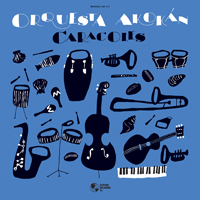
ORQUESTA AKOKAN
CARACOLES (Daptone)
For half a century, Cuba has been restrained from evolving into its place as a cultural leader, as one of the historically richest countries in the Caribbean. This is largely due to the hatred of North America and wont change under the current petty and vengeful regime. Since the revolution there have been chronic shortages of foreign exchange and an increasing nostalgia for the old times — not the crushing poverty pre-Revolution but the days of the big bands of Beny Moré, the Mambo, rum and the thunder of Changó. The Haitians feel a similar nostalgia for the days of Papa Doc: at least then you knew who the enemy was — the state! For the Cubans it is undoubtedly the Yankee imperialist dogs. But amidst the nostalgic backward-glancing, the reverence for the old music bears fruit, first with the Buena Vista Social Club and now with Orquesta Akokán who capture, wonderfully, the sounds of the lush casino orchestras like Conjunto Casino, Casino de la Playa, Arcaño, and even the bands that were big in America, such as Desi Arnaz, and the great Machito who brought swing to the Palladium in New York, or Perez Prado in Mexico. The band's name is a Yoruba word meaning "from the heart," and this their third heartfelt album is as rich and warming as the predecessors. From traditional rumba underpinning the percussion to deep roots in the hidden Yoruba culture of Cuba where you sense the guidance of Eleguá (trickster God of the crossroads), Akokán mine a rich vein of Latin Jazz.
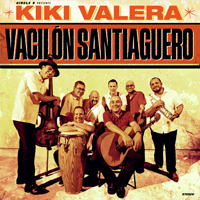
KIKI VALERA
VACILÓN SANTIAGUERO (Circle 9 Records C90007LP)
Kiki Valera is the current director of La Familia Valera Miranda from Santiago de Cuba. Founded a century ago, they are the inheritors and torch-bearers of the Cuban Son tradition. In 1996 they were chosen to portray that heritage on an OCORA recording when Radio France combed the island, looking for prime exponents of native styles. Now based in Seattle, Kiki still runs the family outfit but has issued a second solo album with a lot of guests, including many Cuban trumpet players (among them Alexis Baró), a singer from Spanish Harlem Orchestra and a childhood friend, Coco Freeman of NG La Banda, both of whom were on his previous solo album. In Cuba the guitar is usually secondary for musicians who opt for the unique tuning of the tres [3], but Kiki plays the cuatro [4], which has four pairs of sympathetically tuned strings. Though he studied classical music his real passion growing up was jazz. The album is a mix of covers and originals. It's upbeat and joyous, like a party, and is crisply recorded so the horns don't drown out the varied percussion. The covers are outstanding, and if you know "Funfuñano" (by Arsenio Rodriguez), "Dos Gardenias" or "El Cuarto de Tula" (popularized by Buena Vista socialites), you will be bopping in the aisles to these versions. There's also an outstanding version of "Sobre una tumba, una rumba (over a grave, we dance a rumba)" popularized almost a century ago by María Teresa Vera. Kiki does his star turn with brilliant solos on "La Guajira," "El Cuarto de Tula" and "El Empanadillero," while managing to keep it straightforward enough to echo the era of Ñico Saquito and other soneros of the golden age.
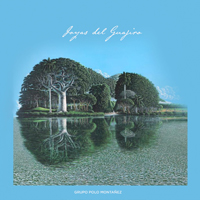
GRUPO POLO MONTANEZ
JOYAS DEL GUAJIRO (Sony/Lusafrica)
Polo Montañez, the founder of this group, died in a car accident in 2002 but his band, based in Havana, reformed in 2014 with a new singer Yosleny Chirino, whom they felt could match Polo's vocal skill. The sound is traditional guajira (Cuban cowboy music): it's simple music with acoustic guitar, bongo, conga and minor percussion like maracas and clave. So it all rests on the vocals and harmony, which is very sweet. The first single "La Suegra (the Mother-in-Law)" bodes well for this project. It's a a slick telenovela-like story to reinforce the well-produced music that accompanies it. On the second track, "Amor del bueno," they are joined by a string section and there's an electric lead guitar (uncredited, but I don't think it's Ry Cooder). Most of the tunes, which were composed by Montañez, are ballads and delivered with stately grace. A couple are remakes from the singer's three albums. Things heat up on "Que sabes tu," and they rock out on congas and bongo on a final rumba.
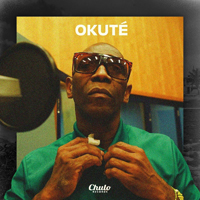
OKUTE
OKUTE (Chulo Records)
This is a blast of pure Cuban music unlike any we have heard in ages. Produced by Jacob Plasse (Orquesta Akokán) it kicks off with a raucous tres over some serious rumba drumming from hard hands used to imprecating and summoning the orishas in centuries-old traditional Lucumi ceremonies in the hills of rural Cuba. While the drumming is exceptional (and beautifully recorded) and the tres evokes the great later spiritual workouts of no less than Arsenio himself (on, say, Primitivo), the vocals are the dominant element. Singer Pedro "Tata" Barriel is joined by a family of percussionists: the Vizcaíno, probably the finest rumberos you could find in Havana today. By the second track, a wailing organ is introduced, which is quite superfluous but compelling nonetheless. Okuté is the Yoruba god of the oceans so in some way behind the transportation of Africans, largely Yoruba from West Africa, to the Caribbean. They had nothing on them except their chains, but were able to fashion drums and even instruments like the marimbula. On the third track, "Chi chi Ribako," we hear "Sarabanda," as a bass takes up the lead and then the tres picks out a counterpoint, again over a thick bed of eight hands slapping. Rumba meets son montuno, but the result is greater than the sum of the parts: I thought a "Sarabande" was a langorous courtly dance associated with Handel, but apparently it originated in central America in the 16th century, was then adopted in Spain where it was considered disreputable! As this anti-sarabande builds, a horn section comes in and we wonder where they can possibly go next! Well, the answer is a delicate string section, over acoustic bass leading us into "Gaston's rumba," another languid piece which then goes quite cockeyed as the tresero, Coto, paints a wild Cubist portrait inviting the others to get in on the simple three-chord progression. The tres also animates another lyrical interlude "Orakinyongo," where again the strings float in on a cloud to show that it's not all hard hands and frantic declamations. These interludes break up the more traditional rumba, which you can imagine goes on much longer than the three or four minutes per track here. However the CD, which is only half an hour in length, is extremely well executed and sequenced and makes you want to put it on repeat.
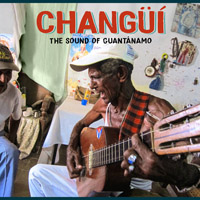
CHANGUI - THE SOUND OF GUANTANAMO (Petaluma Records PET04)
100 degree heat, good vibes and cheap rum are some of the components of a street party in rural Cuba, but you also need music, specifically Changüí, which means "party" as well as a type of rural music, often compared to U S Blues. It arose, like the blues, in the nineteenth century. On a Friday night an itinerant musician would show up with his guitar or tres, and announce himself with a song. Then people would pound on bamboo logs, run a rasp file over a machete, or hit the jawbone of an ass to add percussion, and the music would begin. It was never very formal: the improvised verses could catch whatever was going on. Who's that beautiful girl over there? Oh, she's taken. Well, baby, I can still show you a good time: that type of thing. Other musicians might take over or even jealously detune a virtuoso's instrument when he wasn't looking or steal his pick. The party might last until weary dancers had to pull themselves together and go to work on Monday morning. The compiler of this deep 3-disc set is an Italian journalist, Gianluca Tramontana, who made the recordings with a hand-held recorder over several trips to Guantánamo province. He says the music has not been recorded much, but I have a 1995 CD on the brilliant Corason label which features five groups, some of which are quite well known, and I also have Changüí albums from Yelsy Heredia and Changüí Majadero whose debut on 2016 was noted in these pages. And Elio Revé of Los Van Van popularized the music in the 1950s by adapting it to his charanga. Quibbles aside, this is a fine set and comes with a deluxe book (not a booklet, it's 8.25 x 9.5 inches) in an oversized cigar box, detailing the 50 tracks, with additional essays. What drew Tramontana to Guantánamo? The music there is decidedly Afro-Cuban due to the instrumentation, which includes bongos, marimbula, guayo (a metal scraper, like a cheese grater) and maracas, supporting the six-string tres and call and response vocals. These were also the basic instruments of Arsenio Rodríguez in the 1940s who then added double bass, guitar, trumpet and piano to create salsa out of Changüí's near relative, the son montuno. But Changüí has remained unchanged for over a century, rooted in campesino culture. A parallel sound is Haitian twoubadou music and mento from the Anglophone end of the Caribbean. It's also unpretentious and has one purpose: to make you dance, so there are no ballads! "Latamblé tocando el tres" stands out. It's a song first recorded in 1983 by Grupo Changüí de Guantánamo. Their original tresero, Latamblé, was so good he could play anything: when touring bands came through and didn't bring a piano he would sit in and play the piano part on his tres. He has died but his protégé Carmelo agreed to sit in on the recording of this song in his front room in Guantánamo City in June 2019. Well-known tunes from other repertoires include "Sarandonga," here delivered by Mikiki and his Brothers, and "Guararey de Pastora," from Grupo Estrellas Campesinas (as well as an odd "how-does-this-go-again"? version from Armando Leliebre). This is a deep immersion in a fine and rare cultural treasure.
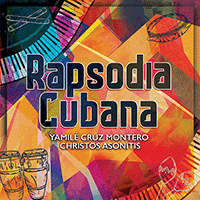
YAMILE CRUZ MONTERO
RAPSODIA CUBANA (Naxos World Music NXW76154-2)
You can't keep a good Cuban musician down. Primarily known as a classical pianist, Yamilé Cruz Montero has been championing Cuban composers like Lecuona and Fariñas, alongside Prokofiev. She made her concert debut at 15. After studies in Havana she took her masters in Munich, winning a scholarship, and went on to receive awards for her performing. Since 2011 she has teamed up with a jazz percussionist, Christos Asonitis, who brings congas, cajón and pandeiro to the set. It's modern classical Cuban music so we hear works of Lecuona and some still-living composers like Ernán López-Nussa, as well as selections from Aldo López-Gavilán and Andrés Alén. But they are bright and sparkle like never before with the quietly ticking percussion urging them on. Alen's adaptation of a Brasilian classic "Tico Tico no fubá" is featured, as well as gems from the son and danzón repertoire. The music alternates between rocking and lyrical pieces, referencing ragtime (in "Zontime no 1") and zarzuela along the way. The latter is a light operetta form in Cuba and is given rein on her version of "Romanza Maria la O," a Lecuona composition, again adapted to solo piano by Andres Alén (with pandeiro accompaniment). Montero's playing is clean, assured and above all joyous -- it's a thrilling disc.
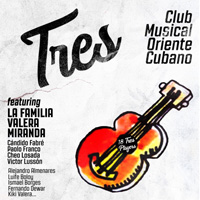
CLUB MUSICAL ORIENTE CUBANO
TRES (3 Sound Record)
This disc came out in Italy at the end of 2019. I was just listening to Familia Valera Miranda again, after their youngest, Kiki Valera, put out a smoking album last month, so it was nice to find an adjunct disc with a line up including Cándido Fabré, Victor Lussón, Cheo Losada, and Alejandro Almenares as well as Kiki and his family. Once again we slip into the warm neuron bath of classic Cuban son and some beloved grooves, starting with "Yo soy el Tiburon (I am the shark)." The totally crazy idea behind this compilation was to set up dates with the best eighteen (18!) tres players from Santiago in eastern Cuba and give each of them one number for their best shot. Duo los Compadres and Nico Saquito provide the repertoire for the next two cuts. It's wall-to-wall classics. Track 4 cracks me up: it's "Hang on Sloopy," sung by gravelly voiced Candido Fabré and featuring legendary Alejandro Almenares on tres. It's a ridiculous corny song in the classic 1-4-5 chord progression, but since Arsenio Rodriguez recorded it in 1966, it's become part of the Cuban tres repertoire. After more modern songs by Henry Fiol and Oscar Hernández we get a serving of "Arrolla Cubano," written by María Teresa Vera, performed by Alendi Reynoso and sung by Luife Boloy, both new to me. There's great muted trumpet on this by Raony Sánchez. I did not known the catchy kitschy "Via Cuba" and a little digging tells me it was a hit in Belgium for Los Chakachas in 1965. The next noteworthy tres solo is Aliandis Mora on "Mambo Guajiro" by René Touzet, sung here by Cándido Fabré. The only flat note is the producer, Paolo Franco, insisted on singing lead on five tracks. When you have vocalists of the calibre presented here, this was a grave error and real chutzpah: one of his friends should have persuaded him to resist. Sure he loves the music and picked up the bar tab, but he should have stuck to playing guiro and singing coro.
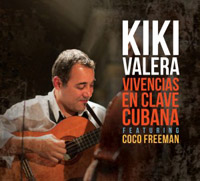
KIKI VALERA
VIVENCIAS EN CLAVE CUBANA (Origin 82790)
Kiki Valera comes from a family which has been playing music in Cuba for well over a century. The family thought it important to collect the musical heritage of the Sierra Maestra region and put out albums of traditional music from their base in Santiago de Cuba (Comprehensive Anthology of Son, two discs on Egrem, 1982). A couple of decades ago OCORA, the publishing arm of radio France, toured the world looking for the best examples of every type of music in every country (I have a shelf of African traditional music they recorded). Ocora's engineers captured a set of classic son and boleros by La Familia Valera Miranda, so this was high praise to be the choice from Cuba. While most son groups feature the six stringed tres, Kiki plays the cuatro which his father taught him. It has additional low strings, tuned F sharp-D-A-E. In addition to cuatro and guitar, Kiki is backed up by upright bass, congas or bongos, and a trumpet. His old friend Coco Freeman is lead singer and there are a couple of coro singers. So it's a small group but they pack a punch. Coco has sung with NG la Banda and Adalberto Alvarez y su Son, a second vocalist Carlos Cascante has won three Grammies with Spanish Harlem Orchestra; the trumpeter, Alexis Baró, has backed Omara Portuondo and appeared in Cubanismo, while bongocero Pedro Vargas has featured in the sublime band of Barbarito Torres. The album was recorded in Seattle and mixed in Santa Cruz, California. There are a dozen original compositions but all of them are in the familiar son style, and in fact it is as well recorded and engaging as those great albums by Barbarito Torres and the other touchstone of great contemporary Cuban Son, grupo Sierra Maestra. Valera is a potent performer with incredible skill and jazz-like invention in his solos; you can tell the band are used to jamming because they interact perfectly when he takes a new turn in a melody, such as the break of "Ferecia." For a small group they fill out the tracks with mambos such as the smoking "Desenfreno,"where the trumpet has been doubled; in addition to congas and bongo, there is the other percussion we associate with Cuban combos, maracas and cowbell. Above all, the musicians emanate the joy they are feeling in playing this music together.
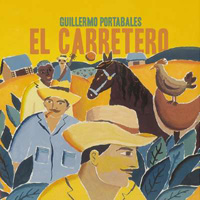
GUILLERMO PORTABALES
EL CARRETERO (World Circuit)
World Circuit is reissuing some of its back catalogue on vinyl for the first time. These well-chosen albums include Ali Farka Touré's Savane, Omara Portuondo's BVSC Presents... and Radio Tarifa's debut album. Portabales (1911-70) played guajira, or country style, Cuban music. His hit "El Carretero" became a classic as far away as Senegal when bands like Baobab added it to their repertoire, and where his "Lamento Cubano" was also adapted by Amara Touré. His group consists of two guitars and bongó, sometimes another vocalist with clavé and double bass join in. He sang, strummed and whistled like a bird while the second guitarist embroidered the melody. His career paralleled that of the more famous Trio Matamoros and another trovador, Ñico Saquito whose magnificent 1982 final recordings also appeared on World Circuit as Goodbye, Mr Cat. The arrangements are very simple and delicate and quite lovely. In the 30s and 40s Portabales was one of the key performers to bring rural music to the cities as guajira evolved and contributed to the formation of son. This is a great album, but not a greatest hits: it lacks "A la orilla del cauto," his version of "Al vaiven de mi carreta," and "Guantanamera." I am not complaining, I am always happy to hear Portabales and this is a well-chosen set, ending with the delicious "Flor de amor." The trova or troubador sound with bright Spanish guitar flourishes is marked on tunes like "Cuando sali de Cuba." The band even gets a groove going on a cumbia, "Cumbiamba," with Guillermo's distinctive vocals praising Colombia.
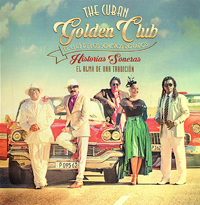
THE CUBAN GOLDEN CLUB
HISTORIAS SONERAS: EL ALMA DE UNA TRADICION (Abdala Productions/Unicorn)
If you thought Cuban old-timey music had lived and died with the Buena Vista Socialists, think again. Since about 1909, trios, quartets, sextets, septets and conjuntos were creating a new kind of folk music called "el son" which became one of the most popular musical forms in and from Cuba. Many memorable tunes were created with a line-up of tres and guitar with bass, congas and bongos, singers with percussion and trumpets. Not surprisingly the best compilation of the music -- hits like "Chan chan," "Cómo está Miguel," "Suavecito," "Lágrimas negras," "Echale salsita," "Como baila Marieta," and "La loma de Belén"-- is called El Son es lo más Sublime. Sometimes guiro and timbales were introduced, and latterly a piano as the music inevitably evolved. The result is a steamy mix, more flexible and denser than salsa, but with more fire than guajira and other folk forms. I don't recognize the names of any of the band members of this latest group of Soneros, apart from singer Felix Baloy, but their guests are legends: Pancho Amat plies the tres on two tracks, Maraca plays flute on one, Changuito and Pancho Terry check in for extra percussive duties. Some of the eight singers featured have performed with Los Van Van, Son 14, BVSC, and Ibrahim Ferrer. In addition, members of the national symphony show up to add cello, violin, viola and flute. For once the tunes are all originals (with a few familiar refrains), although there is a deep repertoire, coming from Miguel Matamoros and Septeto Nacional de Ignacio Pineiro, and Sexteto Habanero (who traveled to Camden, New Jersey, in the 20s to record), whose memories float over the proceedings like weightless beings in a Chagall painting. Real rumba, boleros and danzón all were hybridized into the evolving sound. This album is energetic and has a great warm feel, like it was caught live in the solar, however the mix could be better, as the soloists tend to get lost in the enthusiasm. "La luz del Son" starts out like a familiar ballad then kicks into a montuno, which we could also term a "seben," 2/3rds in where they jam an extended outtro, with trumpets, chekere, cowbell and chorus. This double album follows another single album, again with all original material, released earlier this year.
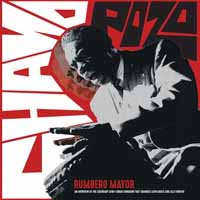
CHANO POZO
RUMBERO MAYOR (Grosso! Recordings GR035)
Arsenio Rodriguez first introduced the African drum known as tumba (and known Stateside as the conga drum) to his band in 1939. Before that hand drums, even including the little bongos beloved of beatniks in the 50s, were banned and kept secret as they were associated with religious Santería rituals. Cuban society was so restrictive they would not even allow black musicians like Rodriguez on the bandstand, though he would perform with Casino de la Playa on record. Casino de la Playa was a big band and ultimately had two tumbadors, one of them singer Miguelito Valdez who hit with "Babalu," the other another showman named Chano Pozo (1915-48). A young light-skinned Cuban in Hollywood, Desi Arnaz, copied Valdez' style and song and, despite his "expressionless and graceless performance," as one critic described it, was a huge hit in the USA. Chano Pozo, on the other hand, was both druggy and thuggy: someone who would not have been allowed in most clubs, let alone on the bandstand if it were not for his talent as a dancer and drummer. Landing on his feet in New York, playing with Xavier Cugat, Tito Rodriguez and Machito, he was in demand, but frequently returned to his home in Havana. Back in New York at the end of the 40s he was discovered by Dizzy Gillespie. Although Dizzy spoke no Spanish and Chano had no English they communicated with music (though neither could write it), going "ding-ding-ding... boom boom" to one another, and together created the fusion known as Afro-Cuban Jazz or Cubop. This new double LP gives an overview of Chano's career which is also a cross-section of the best Cuban & Latin music of the 1940s and 50s. In 2002 Tumbao, the Spanish label, put out a 3 CD set with 144-page book by Jordi Pujol that was the first major retrospective of Chano's work. It included 78 tracks compared to 28 here, but of course these are choice, and include all the important works with Dizzy: "Cubana-Be," "Cubana-Bop" (part of the Afro-Cuban Suite), their smash hit "Manteca" (arranged by Gil Fuller) and "Tin-Tin-Deo" (which became a jazz standard). Of his recordings with Arsenio "El Mago del Tres" there is only "Seven Seven" which will leave you wanting to hear the others. With Miguelito Valdez we dig "Si no tiene' swing." I didnt get any liner notes or even track info with the new issue, but assume the version of Chano's "El Pin Pin" is the version with Julio Cueva and not that recorded with Machito. You can still find the Tumbao set which is authoritative on the used market, and includes all the tracks here. But if you want vinyl, here it is. I don't think there's much they could have done to "fix" the sound of the Havana recordings and they still sound ropey. Still, in a single mic recording the hand percussion is going to be the sharpest sound. It's good to see Chano Pozo getting more notice for his considerable contributions to music, making the bridge between Cuban big bands and jazz.
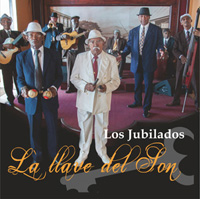
LOS JUBILADOS
LA LLAVE DEL SON (Egrem CD1369)
There is scant information available about this Cuban release. It may be a couple of years old, but the music is timeless, and one of my favorite genres: Cuban Son from Santiago in Eastern Cuba. The cover photo suggests they are veterans of many bands and they are certainly accomplished musicians, whoever they are (Discogs lists some names, all of which link back to the three or four albums released as Los Jubilados -- the Seniors, Elders, or perhaps Retirees? -- but as it has not updated personnel regarding this release, it is possible some of the members have died since their first recordings). Los Jubilados provide originals and reprise some gems: "Catalina la O" by Pete "El Conde" Rodriguez, the ballad "Si te contara" by Felix Reina which I think was first a hit for Ricardo Ray in 1963 (the original is a bolero with a guajira underpinning) and a cooking cover of Joe Arroyo's "Rebelión." They even turn in a romping cumbia. The tresero Rafael Lafarguez is solid (he was also in a group called Santiago Son), the trumpeter is also fine, but I am not sure who is singing. According to a Japanese website they have seven albums out and Pedro Gomez has been the leader since 2006: the original members Juan Ferrer "Bebet" and Mario Caracases having passed away. There is also a woman singer on here. On the traditional material they remind me of my favorite son group Sierra Maestra, who have not been heard from in a decade now since some members got sucked into the Buena Vista vortex to fill empty seats. However, far from dying out, there is loads of youthful vigor in this disc.
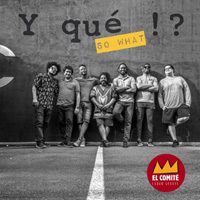
EL COMITE
Y QUE!? SO WHAT (Inouïe)
El Comité are a 7-piece Cuban jazz outfit surrounding piano maestro Harold Lopez-Nussa. Tough and energetic, they serve up a set of originals and covers of "Son à Emiliano" by Gabriel Hernandez, and Miles Davis' classic "So what?" which they've Latinized. Every member contributes something key to the gathering, which works well as classic jazz, and not what you might expect from a Cuban group: there are trap drums, not timbales; upright double bass rather than electric baby bass. The percussionist often plays bells & rainstick in an "Airto-ish" sort of way rather than güiro, maracas or clave. There are two keyboards: in addition to Harold there's Rolando Luna, and they seem to alternate on regular ivories and electric claviers. One of their stated influences is Emiliano Salvador, the Cuban pianist who first brought the harmonic inventions of Thelonious Monk to Cuba. Rodney Barreto on drums and Gaston Joya on bass are solid as underpinning and the latter contributes a wonderful tune, "La Gitana" to the set. The horn section of Irving Acao on tenor sax and Carlos Sarduy on trumpet are top brass. They've added "[Cuban Groove]" to the sleeve to remind you of their origins. Maybe because the drummer is called Barreto I kept recalling Ray Barreto and when they break out the skins on "Son à Emiliano" you really do get a sense of time travel. Two pianos are a great idea, the piano and organ a fine mix (shades of Los Hermanos Palmieri), the breaks reminiscent of Chucho and Irakere in concert, but also keeping the classic Blue Note/Impulse sounds to the fore with the tight horn solos. The label is Inouïe, which is French for "unheard" but I urge you to check it out...
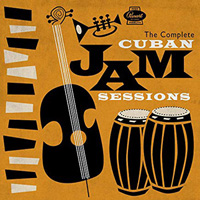
THE COMPLETE CUBAN JAM SESSIONS (Panart/Craft Recordings)
I was curious about this box set which appeared to much hype at the end of last year. I checked my holdings to find I have 3/5 of the set in the form of a CD of two of the albums called Cuban Jam Session vol 1 which came out on Rodven in 1987, and the original vinyl of the Fajardo album which was recorded in 1962. The Cubans are masters of the descarga or jam but the discs I have were not on my "must play" list so I thought I would revisit my stash before splurging on the fancy reboot. Fajardo and his tweety flute left me cold, so I put on the CD which has the Niño Rivera and Julio Gutierrez sides. Again I was not moved out of my chair. Half of the first volume by Gutierrez was OK (side B of Vol 1) and two cuts by Rivera (A2, B1). But again the tweaky flute bugged me. To my surprise I could not find the Cachao album Jam Sessions in Miniature (1957) anywhere in my collection, despite being a huge fan and having ten albums by him. My first thought was someone buying this box might dump their original, so I scouted the record stores. No luck. The next question was: is the sound any better on the box set since it is pretty dull on the originals (on some tracks the flute seems to have been recorded in the bathroom). A friend let me hear the flac of the reissue. I don't hear any improvement: it sounds identical. No question there are some great moments on here: "Theme for conga" by Julio Gutiérrez y Su Orquesta which closes disc one is excellent. The stand out, on relistening, is the set by tresero Niño Rivera. His band overlaps with Cachao's: Orestes Lopez, Cachao's brother (& no less important in the history of Cuban music), plays piano and we hear "El Negro" Vivar on trumpet, Guillermo Barreto on timbales, Yeyo Iglesias on bongos, Gustavo Tamayo on güiro and now-legendary tumbador Tata Güines -- all from the Cachao band. It's this rhythm section that makes the two discs at the heart of the set interesting. The two montunos on Vol 3 are exceptional. Laid back, not cluttered nor forced like the jams on the two Gutiérrez LPs. The Cachao disc starts predictably, partly because they were asked to keep each jam to under three minutes (what is this -- wax cylinder technology!?). Different guest artists step up: trumpet, tenor and baritone saxes and a trombone, but it's not until Niño Rivera comes in for "Oye mi tres montuno" that we get to a sparkling spontaneous jam. Brother Orestes also turns the trick on "Malanga Amarilla," a piano montuno with a great timbales break by Guillermo Barreto. Side B kicks off with the much-anthologized "Cogele el golpe"-- an outstanding jam. It turns out I had the best tracks on anthologies (such as Cuban Counterpoint from Rounder), and on searching deeper I do have the entire Cachao set on a Caney CD from 1994 called From Havana to New York, sequenced differently, which actually does sound better, so I saved myself $100.
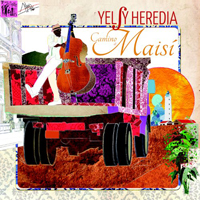
YELSY HEREDIA
CAMINO A MAISI (The Feelin' Club)
Thanks once again to Ken A, our Muzikifan Washington correspondent, I was turned on to this album which came out in 2014. This is a mostly changüí album by a Cuban upright bass player living in Spain. He also takes us on a tour of many other styles of Cuban music, with piano, flute and bountiful percussion. Heredia was born in Guantánamo in 1978 but has been gigging for years with the likes of Bebo and Chucho Valdés, Diego el Cigala, Salif Keita and others. Looking at his discography, I see he has also performed with Tata Güines, Guillermo Rubalcaba and Changuito, as well as many tango and flamenco artists. For this outing he revisits his homeland, featuring "El Guajiro" Fernández on lead vocals and Dayme Arocena as female lead singer on "Hermosa Santa," a hymn to la Virgen de la Caridad del Cobre, which has a bembé rhythm. The main feeling is Latin Jazz, though the flute and noodly soprano sax push it a bit towards easy listening -- but it is by no means an on-the-nod session. There are some fiery approaches to traditional rhythms (heavy on percussion): the title track is a fine changüí. And the bass is to the fore, appropriately, reminding me of Cachao. "No te olvides" has lovely harmony singing over a simple maraca and clave beat with the bass soloing behind. Other highlights are the cha cha cha and danzons they deliver in a stately manner, where the flute works well.
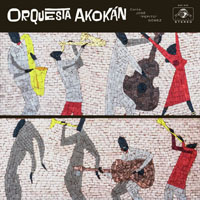
ORQUESTA AKOKAN (Daptone DAP-052LP)
I love old Cuban music, all types, including the big band mambo that makes you realize that ultimately you become your parents. Even if my parents didn't dance to mambo I am sure they snapped their fingers and tapped their toes when Pérez Prado launched forth into "Cherry pink and apple blossom white" or "Patricia." Akokán, with the benefit of hindsight, have revived many aspects of classic Cuban music, highlighting percussion and individual instrumental talents on their debut self-titled album. Their vocalist and composer José "Pepito" Gomez assembled the 16-piece Orquesta Akokán (their name is the Yoruba word for "from the heart"), including four saxophones & two trombones, to keep the sound of Beny Moré and Orquesta Aragon alive with sheets of brass. Though some of the band are based in New York, there are many Cubans in their ranks and so they naturally wanted to record in Havana's legendary EGREM studios. This not only put them in the mood, it helps create the 1940s atmosphere that is essential to their sound. But it has a bigger, fuller sound than the mambo 78s of yore. The excellent sonic qualities indeed recommend this as a superb hi-fidelity experience, and every nuance of percussion is clearly audible. Pianist Mike Eckroth is also a devotee of the Cuban piano sounds of the 1940s (an era long before he, or Gomez, was born), but wrote a doctoral dissertation on the music, which exposed him to enough material in great detail that he is now an accomplished arranger. The Cuban experience was not without its challenges for the novice band. There were blackouts in Areito 101, the studio, plus a shortage of paper for printing out scores, but one of the biggest obstacles was finding the window after Obama's normalization of relations with Cuba in 2014, before the fascist backlash of the Un-Obama era set in. They handled the difficulties with ease and spent three days in the studio laying down a sweet, beautifully realized album.

LOS RUMBEROS DE LA BAHIA
MABAGWE (Eguin Eje Records)
Three rumberos dreamed about making this album for years, as life passed them by. Michael Spiro is now Associate Professor of Percussion (!) at Indiana University but paid his dues working in bands like Santana and David Byrne and backing musicians such as Ella Fitzgerald, Cachao and McCoy Tyner. José Luis Gomez is a Cuban who grew up playing in comparsas in his hometown of Sancti Spiritus. He went to Africa in the late 70s and worked as a basketball coach. Back in Havana he participated in street rumbas put on by the Conjunto Folklorico Nacional de Cuba, before moving to the San Francisco Bay Area in 1982 where he got to work with Pancho Quinto, Giovanni Hidalgo and other luminaries. He became vocalist with Fito Reinoso's Ritmo y Armonia, and played on recordings by the Coro Folklorico Kindembo of John Santos. These two friends finally teamed up with Jesus Diaz (another percussionist/ vocalist with a lengthy pedigree, even overlapping with the others in groups like Santana or Sheila E) to put together a purely traditional album devoted to their elders — "Los Mayores". The title Mabagwe, is a Yoruba word meaning "Remembrance" and though the African roots are pronounced (the songs are often devoted to Afro-Cuban orishas like Chango), and there is a hint of Spanish decimas in the call-and-response vocals, rumba is a purely Cuban form, expressed here by these three elders with a group of recent immigrants from Cuba. The obvious connection, if you are not familiar with this music, is to the Muñequitos de Matanzas in that is is primarily percussion with vocals, to accompany dancing. But in addition to keeping tradition alive, the music evolves and they have written new material reflecting contemporary concerns, from veiled political commentary to simple exhortations to shake your bum.
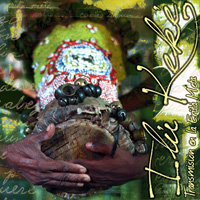
ILU KEKE
TRANSMISION EN LA ERITA META (Music Works)
Ilú Keké is not a person nor a group, but a trio of batá drums that hung for over a generation, neglected, on the wall of a house in Matanzas. The importance of these drums is that they may be the oldest surviving drums from the time of slavery in Cuba and were constructed as sacred vessels to contain the spirit of the God they invoked. Within the tradition of Santería this god is known as Añá. These drums were likely made in a nearby sugar mill in 1830, and have aprons and bells attached as ceremonial appendages for rituals. The producers had heard about these drums from an old musician who recalled seeing them in the early 1950s, but subsequent stories told of the owner's keeping their usage a secret so they were passed on to descendants who knew nothing. One owner famously was more interested in women and flashy clothes and died while getting it on. For 50 years the drums were merely ornamental curios but have been returned to their intended use and are the focus of this recording. The disc starts with a long recitation (it's a prayer so the strict integrity of the performance is maintained), so I skip to the next track, a limpid drum exercise with jingling bells meant to invoke Eleguá. Then "Caminando por la marina" takes the mike on a stroll outside for a walk to the ocean as we hear the drums through the walls of a building, along with motorbikes, market sounds, etc. Things get serious by the fourth track, which is a chant to Ogún, preceding by a train horn. The whole panoply of Santería divinity (the worship of Yoruba gods) is here, including Changó the deified West African king from the 1500s. Although I am not religious in the practical sense, I have an abiding interest in the gospel of Robert Farris Thompson, Flash of the Spirit (there is a PDF on line if you have not read it, but a physical copy is necessary). Thompson's book elucidates the African gods and how they re-emerged in the New World, sometimes disguised as Catholic saints; it is a useful guide for atheists like me to approach spiritual transcendence or at least understanding when exposed to music such as this. Matanzas is home to some of the main drum and chant groups surviving today, so members of Afrocuba de Matanzas were brought in to consecrate the rediscovered (& recovered) drums and perform for this recording. The title means Transmission at the Crossroads, though actually the intersection is a Y, where the roads between the village and the sugar mills meet. The recordings are sharp, and not just acoustically clean studio sharp, but street sounds float by also. It is authentic, not sleek and refined (pure cane, not granulated white) and brings you right into the midst of a centuries old ritual.
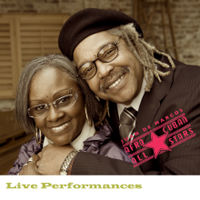
AFRO-CUBAN ALL STARS
ABSOLUTELY LIVE II (VIVA MEXICO!)
Live Volume I from these Afro-Cubists was captured in Japan in 2001 (& got a scathing review from yours truly on the bottom of the "Cuba part 4" page). Just as the body replaces all its cells every 7 years this seems to be a new generation of the band. This new recording, from an evening in the magnificence of Guanajuato, Mexico, is strong, especially on the classics, "El cuarto de tula," and "Tumba y bongo" of Arsenio Rodriguez. It's a good show, lots of familiar oldies and no grandstanding this time out. It's a bit vain calling them All-Stars since they are really a bunch of unknowns, but they needed the grandiose title when they backed the famed Buena Vista Socialites. (The reverse is true of the West African Highlife Band which truly is a line-up of All Stars performing under an unassuming name.) The leader is Juan de Marcos Gonzalez who was plucked from the ranks of one of the greatest Cuban bands, orquesta Sierra Maestra (who preserve traditional music, and who also gave birth to Cubanismo), to assemble a band in the old Egrem Studios in Havana when Nick Gold of World Circuit had the idea of bringing African soneros to Havana to record with the old-time Cubans. That time the Africans didn't make it and they settled for Ry Cooder. Later they did come, and you can hear Mar Seck, Laba Sosseh and Pape Fall on the Popular African Music CD Los Afro-Salseros de Senegal en la Habana. The other problem -- also endemic with Africando -- is, if you induct some retired musicians into a band they burn out and die at an alarming rate. So the early stars of this band: Pio Leiva, Ruben Gonzalez and Ibrahim Ferrer all died over a decade ago and have been replaced by 14 suitably youthful performers of distinguished pedigree. Clarinetist Laura Gonzalez is grand-daughter of Marcos Gonzalez and great-niece of the brilliant pianist Ruben Gonzalez, and it turns out daughter of Juan de Marcos, so we learn indirectly he is the son of one of Arsenio's singers. Juan de Marcos stirs up the crowd by yelling "Viva Zapata," etc, but they are already predisposed to party and dance with abandon to the songs their parents also loved.
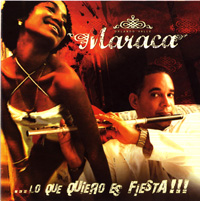
MARACA
LO QUE QUIERO ES FIESTA!! (Ahi-Nama AHI1078)
It's been a while since we heard from Cuban flautist and bandleader Maraca. He has been touring -- Cuba, Mexico, Africa, Europe, North America and Reunion Island, and trying different styles of music. He brought a band to Yoshi's at the end of August 2008, but it was a band of expatriates (plus Craig Handy, an African-American jazz saxophonist as the stand-out talent), because his regular band of Cubans cannot tour the United States. Maraca (Orlando Valle) has a French wife and lives in France. Despite the different line-up he previewed the new album and it went over big with the dancing crowd in Oakland. It starts out straight-ahead salsa but then nuances into guaguanco, guajira, and even a cumbia. "Lo que quiero es fiesta" sounds very Colombian and even features an accordeon. When they did an old Beny More standard I was over the moon. The sound was muddy but IJ went back the next night and said they had straightened out the sonic problems. The album features his regular Latin line-up but also electric guitar on five tracks. I of course would have preferred a tres, but there's plenty of traditional Cuban craftsmanship on display on piano (Alejandro Falcon), electric bass (Sergio Raveiro) and congas (Rafael Valiente). Luis Valle multi-tracked his trumpet & trombone, and there's Andres Perez on baritone sax. Vocals are handled by José-Miguel Melendez and Lester Hojas with Ammiel Castellanos shouting encouragement and a guest appearance from "El Nene" on a guaguanco dedicated to the late great conguero Tata Guines. Ceaseless touring has sharpened Maraca's band to a fine point. He drives from the sidelines, pointing out solos, singing coro, counting down to the chorus and adding percussion to the groove. He is a superb flautist but doesn't hog the mike. The title track is excellent, and so is the coda: the little percussive tribute to Tata Guines. Live, my favourite track was "Guajira para Mimi." High-energy party music to make you wind your waist.
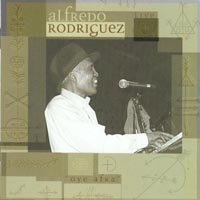
ALFREDO RODRIGUEZ
LIVE: OYE AFRA (OP118)
Mike Charropin, despite the name, is Alfredo's wife, and she has selected her favourite performances from among the live recordings he made on tour in Europe between 1998 and 2005. It starts in a sodden wet mood in Vannes 2001 with "Claudia," credited to Chucho Valdez, but actually it's the theme from "Un Eté 42" and if I were Michel Legrand I would be calling my lawyers. The audience recognizes it and eats it up as it sparks up into some deft trinkling and bravura conga slapping from legendary Tata Güines. (His name is pronounced "Weenies" rather than like the Irish malt beverage, and with Tata as his first name it's a good thing he's Cuban.) Actually it could be one of five other congueros too as there's a huge list of credited musicians not specific to any one song. There's a distant violin solo, like from across a vast arena, but at least the mike is close to the piano. Faint jazz horns join in for a crescendo. Next we get three songs in a row recorded in Athens in 2003, definitely featuring Tata Güines & Changuito. The piano is to the fore yet it's mellow, in fact it's not so much a big show as the kind of music you want on in the background when you are relaxing, cooking, or simply pondering. By track 4, "Mario's Blues," we are in descarga heaven with the hovering violin of Ruben Chaviano, prodded by wild timbales, and some hard sax from either Jose Carlos Acosta or Marco Agoudetse. We go from a Son Montuno, played by a trio, to a classic danzon: "Almendra," complete with flute, and some brilliant piano improvisation. (I love it when a pianist can go from Rachmaninov to Bobby Weinstein's "I think I'm going out of my head" in the course of four bars without blushing.) But then we get into an outro jam of "Oye como va" that detracts from the mood. Next up "Summertime," by Jorge Gershwing, that famous Cuban. The trio returns (to Paris) for a smoking "Tres palabras"; I am not sure who the featured bassist and conguero are but it is hot, hot, hot. The title track, an Afro, or Yoruban praise song to Yemaya, predictably, goes through the roof.
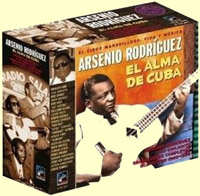
ARSENIO RODRIGUEZ Y SU CONJUNTO
EL ALMA DE CUBA
GRABACIONES COMPLETAS RCA VICTOR (Tumbao TCD 315 2007)
Some of us have waited a long time for this: the complete RCA Victor recordings of Arsenio Rodriguez, made between 1940 and 1956. Arsenio was the tres player who revolutionized Cuban music, changing the traditional septeto line-up and adding more rhythmic complexity to it with a piano and tumbador (conga drum), and doubling the trumpet. His tumbador player was his brother Israel "Quiqui" Scull who ended up in jail after stabbing a man and was replaced by "Chocolate" Alfonso while he served a 4-year stretch. When Quiqui returned the band had two tumbadores and they were celebrated in the son monuno, "Kila, Quiqui y Chocolate." "Papa Kila" was the bongocero, considered the best in Cuba. By then, Summer 1949, the band had consolidated with the two top trumpeters, Felix Chappotin and Chocolate Armenteros, swelling the ranks. Arsenio's music had a huge impact in the barrios of Havana where his son montunos and guaguancos were all the rage in the 1940s & 50s. The fact that two of his musicians were called "Chocolate" should remind us that pre-revolutionary Cuba was a racially divided society, and club patrons wanted to see light-skinned musicians on the bandstand. Not that Arsenio, who was blinded at age 7, gave a damn. He was really interested in the roots music he picked up from his grandfather who had been brought from Congo as a slave to work the sugar plantations.
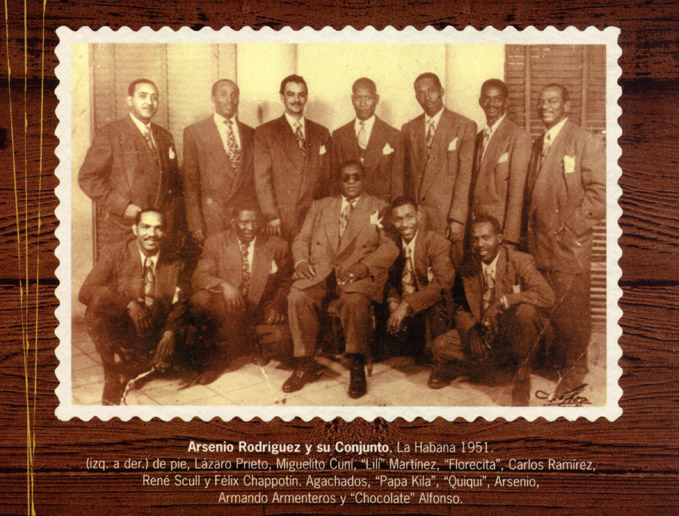
Arsenio y su Conjunto, La Habana, 1951
Standing: Lázaro Prieto [double bass], Miguelito Cuní [lead vocals], "Lili" Martinez [piano, arranger], "Florecita" [trumpet], Carlos Ramírez [guitar, backing vocals], René Scull [vocals], Félix Chappotín [first trumpet]
down in front: "Papa Kila" [bongo], "Quiqui" [tumbador], Arsenio [tres], Armando "Chocolate" Armenteros [trumpet], Felix "Chocolate" Alfonso [tumbador].
Despite attracting the best musicians in town, Arsenio's conjunto only got into the studio sporadically as the first two discs cover a six year period. It was the era of the Second World War and while Batista was an ally of Roosevelt, Cuba did not participate (other than sinking a stray German sub). On their third date the conjunto cut "Como traiga la yuca," featuring one of the most scorching tres solos ever laid down. The song, laden with double-entendres, became known as "Dile Catalina," because of the opening words. Arsenio had arrived. In "Sandunguera," Bustillo on trumpet quotes "Stormy weather" as Lino Frias goes off on piano. I doubt you could hear a more up-to-date Latin band anywhere on the planet today. In fact Lino gets more solo time than Arsenio on these early sides. Only three songs from the first disc have been anthologized on CD before (on the Harlequin disc), though a dozen of these early rarities appeared on the rare Cubanacan disc from Puerto Rico I was able to track down through Round World Music, years ago. But some of us in the hard core Arsenio collector's league have been sharing CDs made from 78s that Emiliano Echeverría has been playing on KPFA radio as a New Year's Day treat for several years. Now everyone with an interest in great Cuban music can get a major slice of the pie.
I am constantly impressed by what a backseat driver Arsenio is. He only occasionally steps up to the mike to lay down a solo statement (like on "Cuba cha cha cha" recorded in New York). The arranger of the band was usually the pianist, and fans of Buena Vista S.C. will thrill to finally hear the debut recordings of Ruben "El Bonito" Gonzalez who cut 11 sides with the band in 1945. (It really pissed me off when that idiot who did the documentary on Buena Vista Social Club was whirling around Ruben and wandered off just as the late great pianist started showing photos and talking about his days with Arsenio!) Ruben's replacement was Luis "Lili" Martinez, one of my favourite Cuban pianists, who, incidentally, was the sole white member of this magnificent conjunto. Many bands made big cash offers to Lili to entice him away but he had found his spot, and the 7 years he played with Arsenio epitomised the perfection of Cuban son montuno. For me, the dozen 1946 recordings (which appeared on Montuneando [TCD031]) with Lili are the pinnacle for this group: "Chicharronero," "Dame un cachito pa'huele," "El Reloj de pastora," "Cangrejo fue a estudiar," "Juventud Amaliana" & "Semilla de caña brava," are stunning in their brilliance.
There is no doubt that this box is a labour of love. There are two booklets: one by producer Jordi Pujol Baulenas, the other by David Garcia who wrote the definitive book about Arsenio's music (I should have acknowledged his sending me a copy sooner!). Some of the tracks are from scratched 78s, one ("Me quedé sin ti") was so bad they didn't include it, and one or two sound a little out of round here and there. But it only focusses you on the fragile beauty of it, like listening to Robert Johnson or Skip James on their early sides. There are 151 songs here. Previously Tumbao has released 33 of them on two single discs. If you have those discs, and are not a completist, then be happy with what you have. Filling out the set is for compulsives and obsessives who will pay the huge entrance fee just to check it off on their landmarks list (like tourists leaving the Taj Mahal without a second thought or look back, wondering how long to Fatepur Sikri). But doubt not this is the Taj Mahal of Cuban music: an exquisite shining bittersweet monument, ringing with stinging tres riffs, shrill trumpet volleys, trinkling piano rills, crisp slapped bongo, resonant tumbabor & double bass. (Leave your shoes at the entrance.) The cream of the crop, from "Cangrejo va estudiar" to "Dundunbanza," is already on the market, but if you have a hankering to hear Arsenio work out on Harold Arlen's "Sobre el arco iris (Over the rainbow)", among other wonders, then you surely need this box set. I am ecstatic to find the original "Cero guapos en yateras," recorded on the same hot June afternoon as the exquisite "Cangrejo fue a estudiar"-- the band passing around a joint, a bottle of rum -- they knew it so well, having worked it up in concert -- laughing inwardly when Arsenio winds it up for a vertiginous solo, but then he suspends time and space and everyone, agape, has to drop out except the percussionists. Wow! what just happened? -- It's gone in an instant; the band pulls together for a final chorus, but thanks to Nipper and his magic Victrola, You Are There!
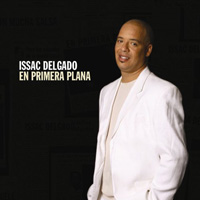
ISAAC DELGADO
EN PRIMERA PLANA (La Calle Records B000PC6FVQ)
I had to check this out because my old boss Robert of Round World was raving about it in THE BEAT. But then he is clearly biased while I was never a huge fan of timba. Twenty-some years ago he dragged me to see NG La Banda at the Galeria Showplace in San Francisco (the worst in a city of bad musical venues), a tall empty echoey building. We found the only place we could hear ANYTHING was behind a column on the stairs on the second floor, behind the band, where the reverberating mud balanced out to make a sound like a boomy car radio heard through the cinderblock walls of a Miami motel. That night I concluded NG stood for "No Good"! Craving more artistic freedom, which like so many things is green and wrinkled, Delgado has moved to Miami where he was able to team up with some Cuban legends to record this album. Cachao, Gonzalo Rubalcaba and Giovanni Hidalgo are on here. They are all brilliant individually and I am sure their fans are in ecstasy over this release. There is one outstanding track: "Cemento, Ladrillo y arena," where Hidalgo goes off and Rubalcaba throws out some great chops but it goes into a long fade instead of a resolution. The disc ends with a decent changui. While it may be a must for NGs & Van-Vanistas, overall this disc left me feeling, once again, like I was backstage trying to enjoy something I couldn't quite get.
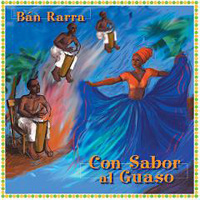
BAN RARRA
CON SABOR AL GUASO (Salsa Blanca May 1-1112-02)
After the recent "back to Cuba" longings of Papa Noel and Ricardo Lemvo, among other African performers, it's nice to hear some classic traditional Cuban son. Bán Rarra was recorded in California, but hails from Guantanamo, Cuba. The only "famous" member is bassist Yunior Terry of the legendary Cuban family Los Terry who usually only manage to record by the miracle of overdubbing since he is resident in the States while the other members of his family are back in Havana. The sprightly tres (played by Miguel Martinez) and guitar are gently plied while the percussion (clave, bongo, guiro, maracas, guayo, campana) is clean and crisp. There's son, nengón, changui, kiribá and other styles here, including folkloric ones that are rooted in Voodoo which is Haitian rather than Cuban in origin. For the nengón, a large wooden sound box, the marimbula, replaces the bass, and the dancing montuno tres (played here by Jon Griffin) is joyous and exuberant. "Rico Vacilón," a cha cha cha, follows this. It's not the Palladium Ballroom style of cha cha but the folkloric one. If you want a great introduction to these traditional Cuban styles, check out the 4-CD set OFFICIAL RETROSPECTIVE OF CUBAN MUSIC, which is also available from Salsa Blanca's website. However for a sampler, this disc has integrity and unexpected moves. (Plus it's a bargain at only $8.) The stately tres and raft of percussion is augmented by timbales for the mambo medley. We end up with a conga oriental: if you like the sound of Ornette Coleman jamming with the Joujouka tribesmen, you will dig this. It's wild. This is a wide-ranging yet succinct and coherent package, and it's thoroughly enjoyable.
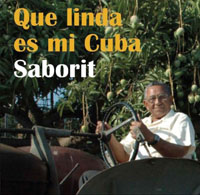
SABORIT
QUE LINDA ES MI CUBA (TUMI 134)
Like anyone, I go through musical fads where I listen to a lot of one kind of music and then turn it off. I hardly listen to South African music any more, and recently have had enough Nigerian funk to last me a long time. Occasionally I surprise myself when I am driving, listening to tapes in my car of my radio show from a decade ago and there's a great set of diverse music. But DJs are supposed to have broad and eclectic tastes. I don't need to hear "Guantanamera," and if I want to hear "Lagrimas Negras," "Chan chan," or "Suavecito," I've got the classic CUBA - EL SON ES LO MAS SUBLIME (ASPIC X 55513) close at hand. But I never get tired of the sparkling son of Cuba, especially when there is a good laud or tres player on the session.
Grupo Eduardo Saborit come from Manzanillo in Eastern Cuba. They keep their campesino or country sound vital, absorbing outside influences like cumbia, and writing their own material, in addition to covering tunes from classic (Electo Rossell Chepin's "El platanar de Bartolo") to contemporary (Candido Fabre's "Dame tu amor Guantanamera"). There's a funny and touching story connected to this recording. Though the band members have been playing individually for 40 years and have a radio show in Manzanillo (near Guantanamo Bay), they have not had much recording success. When Mo Fini of Tumi Records went to Havana to supervise a recording session the engineer told him there were some people waiting to see him. He went out back and there was a parked tractor and trailer. The trailer opened and immediately the 8-piece conjunto broke into song! (They had driven all the way to Havana in this conveyance.) Fini was so moved -- quite apart from the funky smell and the fact they had been waiting three days for him to show up -- that he signed them on the spot & produced this, their first album. They turn it on for son montunos and guarachas, then their first cumbia, "Amargo dolor," is a beauty, and this is followed by a pilon, "El platanar de Bartolo" which rocks out and doesn't let up as they go into more sons, guarachas and congas. This is the best new traditional Cuban album I have heard since Sierra Maestra's SON: SOUL OF A NATION last year.
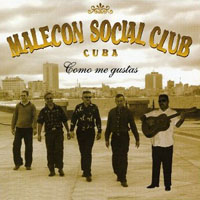
MALECON SOCIAL CLUB
COMO ME GUSTAS (Chant du Monde 276 1408)
I don't think Nick Gold will be losing any sleep over this release. Someone trying to cash in on the played-out "Social Club" name has assembled a group of veteran Cuban musicians to go through chestnuts of the son repertoire. I believe Vieja Trova Santiaguera was the first such group, concocted by a foreign businessman. But of course Cuba, particularly Santiago, is full of readymade groups who have been playing together for years and have the chops. This new group is quite talented but the overall impression is of a tired revival. After "Lagrimas Negras," "Dos Gardenias," "El Carretero" and "Viente Anos," I am sure I am not the only listener yelling "basta!" They get it together for "Toda una vida," a sleepy ballad by O. Farres. I do have a soft spot for Pablo Milanes' "Yolanda." Remember Robert Wyatt's version? Though I tend to shun Nueva Trova, this song has a perfect cyclical chord progression. The cover shot of "Como me gustas," of the band walking along the malecon in Havana, reminded me of Barbarito Torres' HAVANA CAFE, still one of the best son CDs ever, but there's no one approaching his calibre as a musician on here.

FAMILIA VALERA MIRANDA, ANTOINE "TATO" GARCIA & SABRINA ROMERO
CANTOS DE IDA Y VUELTA (Long Distance 0610206)
You like steak and you like shrimp, right? But are you the kind of person who orders steak AND shrimp? If so, you will enjoy this album which unites Cuban and flamenco music. Actually there's a lot to enjoy here: the jangling acoustic guitars and clave of Cuban traditional music with the hoarse vocals, handclaps and flourished strings of flamenco. Catalan gypsies have long adapted sones, changing lyrics or tempos to refashion Cuban songs to suit their needs. "Negro bembon" became "El Gitano Anton" in the Catalonia of the 1950s. When the late Compay Segundo performed "Sarandonga" at a music festival in Perpignan, the gypsies were electrified: wasn't this their very own essential gypsy wedding song? Someone had actually written this, and not only that, here he was singing it?! So producer Guy Bertrand had the idea to bring together the best gypsy artists he could corral with the renowned Familia Valera Miranda, keepers of the flame of the traditional son since the 19th century. It's a great set and swings back and forth between the sympathetic styles though mostly sounding Cuban. The decider is where I will file it. Yes, there are a couple of chestnuts on here ("Sarandonga," "Lagrimas negras"), but they are imbued with original ideas and subtleties in interpretation that make them fresh and enjoyable.
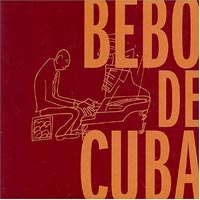
BEBO VALDES
BEBO DE CUBA (Calle 54)
This is a deluxe package, containing two CDs, a 60-page book, and a DVD. I haven't watched the DVD yet, but have really been digging the two albums SUITE CUBANA and EL SOLAR DE BEBO for the past month. Pianist Bebo is one of the giants of Cuban music, having risen to prominence in the mambo era of the late 40s. He was in the first Latin jazz jam sessions and steered many young artists to fame, but he took a powder and vanished into obscurity in the 1960s when he was on tour in Europe with the Havana Cuban Boys and he fell in love and settled down in Stockholm. He re-emerged 35 years later with the latest wave of rediscovered Cuban old-timers. He had a huge hit with BEBO Y CIGALA, his duets with flamenco vocalist Diego el Cigala, and released his first solo album BEBO last year. These two albums are quite distinct: EL SOLAR DE BEBO is a classic jam session with some fine contributions from Paquito d'Rivera on reeds and Juan Pablo Torres on trombone. The rhythm section (New York's finest: Andy Gonzalez on bass, Milton Cardona on congas, Steve Berrios on drums, Edgardo Miranda, guitar and tres, etc) cooks along waiting for someone to step up and solo, so there's a really relaxed air and of course it all comes together for those little epiphanies when it locks into a groove and goes up a notch. Bebo's playing is lyrical, he uses a lot of boleros as a starting point. This album could be from the 50s except it's a really crisp recording (I mean you will hear quotes like "Theme from a summer place" and other chestnuts of Latin jazz improvisation). While EL SOLAR is a mellow jam session, the other disc, SUITE CUBANA, shows Bebo at his best, as a composer and arranger. Here he has assembled a big band to recreate the style of his lush outfits in Havana back in the extravagant days of card sharps with diamond stick-pins and showgirls in ostrich feathers. Bebo wrote the piece in Stockholm in the 90s; each part is in a different style, starting with a mambo dedicated to his buddy Cachao. "Devócion," a bembé in 6/8 time seems dissonant (unless you are familiar with this style of music from, say, the Fort Apache band) until the big wall of brass starts to soak its colours throughout. There are four trombones, five trumpets and five saxes, so there's a lot of wind. Even when Bebo is just holding down the montuno part on piano, you glimpse him through the big arrangement, like on "El son de Cecilio," which has a wild tenor solo from Mario Rivera. The guaracha-mambo "Ecuación," has Diz written all over it, though there's a hint of Desi Arnaz too in the comfiness of it! The centrepiece of this disc, it's in the style of Dizzy's famous Latin jazz suites, and ends with the famous horn line which I always hear as "Chano Pozo buddly-bup-tee." Bebo Valdes is 86 now but writing, arranging and playing like the master he is.
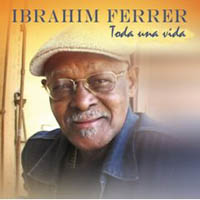
IBRAHIM FERRER
TODA UNA VIDA (Dynamo Records DYNR009CD)
IJ loaned me a DVD of Pio Leyva in concert. I am always trying to get people to pay attention to the living Cuban artists instead of those tottering on the brink of oblivion in the Buena Vista Terminal Ward. Sadly however, Pio has lost the plot, and the best part of the show was the conga solo. But Death has not slowed down the career of Ibrahim Ferrer and, indeed, his music seems to be improving. His latest is a studio date with the energy of a live performance bearing a 2005 copyright date and no other information (It's a promo, also loaned to me by IJ). Apparently recorded in the 1950s, it is a slamming set, that doesn't let up, connecting salsa to earlier traditions in Afro-Cuban music. A trawl through the web yields no information, other than the usual hopeful "Be the first to write a review" appeals from merchandisers. The Dynamo Records website says "We are currently preparing an album of unedited material from Ibrahim Ferrer including four tracks never before released in Europe." I suppose it's not that important who is playing on here. Ferrer is in fine voice, though the EQ is a little off-kilter in places. He has a lot of eager youthfulness matched by the fiery ensemble playing, super-duper timbales and congas, a big horn line with a shrieking trumpeter, undermiked tres, keen coro, piano and bass in the pocket. This is (mostly) how it's done (not the undermiked tres). Hopefully some of those folks with the heirloom Buena Vista collection and nothing more will latch onto this and have their grey hair catch fire.
Update from press release: These tracks (11 of which were unreleased), were recorded during Ibrahim's times with Pancho Alonso (who he performed with for over 20 years), the Orchestra de Chopin and Benny More.
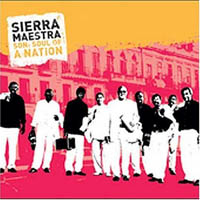
SIERRA MAESTRA
SON: SOUL OF A NATION (TUG CD1039)
After the thin sound of the GV 78s it's nice to get the big room boom of some classic Cuban music as delivered by the reliable Sierra Maestra. They took a sabbatical as their leader Juan de Marcos Gonzalez was seduced by the bright lights and launched off an endless world tour with the Afro-Cuban All Stars. Their last four albums were recorded in Europe, but now the group are back home in Havana and have found a niche in an old studio for this beautiful recording. Times have changed: no one is guzzling rum before the session and few of them smoke. In fact, Havana, the cigar capital of the world, has just enacted laws banning smoking in public! All that whizzing about Berlin and London left their last few albums seeming a little distracted and the break has been good for the group who are all turning 50 and about to celebrate 30 years as the saviours and leading exponents of the Cuban Son (They started as university students in 1976). This time out they are sure of their goal: nothing short of a complete retrospective of the evolution of the Son from its earliest incarnation in trios like Miguel Matamoros', up through the big band sound of the 1960s. They have cherry-picked great songs from Nico Saquito's "Al vaivén de mi carreta" to Beny Moré's "Santa Isabel de las Lajas," from Arsenio Rodríguez' immortal "Bruca Maniguá" and "Dile a Catalina" to Ignacio Piñero's soaring "Suavecito" and Miguel Matamoros' "Olvido." It is sublime from beginning to end. Yelfris Valdés on trumpet is a fine new addition. He's filling big shoes -- it's a position once held by Jesus Alemany, founder of Cubanismo. The great Barbarito Torres adds his magical lute to "Al vaivén de mi carreta." (I wonder how many times he's played this? I certainly have many recordings of it, and never tire of this classic.) Emilio Ramos on tres is a suitable replacement for Juan de Marcos, and the bassist, Eduardo Himely is now assuredly in charge as musical director. I can't believe they haven't recorded "A la Loma de Belén" before: it seems like it should be their signature tune. But then so do many of the other classics of this repertoire, like Lili Martínez "Mi son, mi son, mi son," a paean to the music with the great line, "Tengo en mi casa una pareja de gata con ratón que bailan son (I have a cat and mouse at home who dance the son together)"! Midway through they take it down to the congas for a great guaguanco "El Paso Franco-Bardo," where high-voiced singer José Antonio Rodríguez really soars with only the bass accompanying him until the outro. Rodríguez packs emotion into "Suavecito" -- the booklet has the complete lyrics of all the songs so you can follow what he's singing. If you want something that's classic but fresh, no need to look further than this. Instead of a retread of some old tired soneros check out the vital sounds of Sierra Maestra.
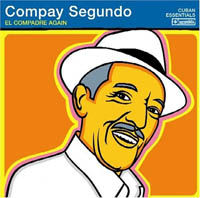
COMPAY SEGUNDO
EL COMPADRE AGAIN (Cuban Essentials ESC 6516-2)
It's a well-known fact that Jimi Hendrix only released ARE YOU EXPERIENCED, ELECTRIC LADYLAND and then AXIS: BOLD AS LOVE before dying, but if you go to a record store you will see over 30 CDs by him. On closer inspection you will find that his repertoire "Red House," "All along the watchtower," "Purple haze," "Voodoo chile," etc appear on all these other albums in varying degrees of fidelity. Now that Compay Segundo has died, right after being discovered by the Buena Vista set when he was up in his 80s, there are more and more albums by him coming out. And so, once again, we get to hear his classic "Chan Chan." Otherwise it's an interesting set from this back-up singer who had the good fortune to be surrounded by excellent musicians in his sessions. The Cuban Essentials series aims to put out "Best of" compilations of the Usual Suspects: Eliades Ochoa, Ibrahim Ferrer, Omara Portuondo -- also known by my pal Steve as "los Teletubbies Cubanos". Take another analogy: photography. After his death the work of Walker Evans soared in value and now there are literally dozens of monographs on him including, inevitably, "the Lost Work" (which begs the question if it is no longer lost shouldn't it be called the Found Work?), while other equally interesting WPA photographers, Vachon, Lee, Rothenstein, etc, are completely ignored. Returning to Cuba, Pio Leyva, I believe, its still alive. Where is the hoopla about him, the box sets, the tribute albums, the all-star sessions? You could pick several other singers and ask the same question. If you like the repertoire of Casa de la Trova groups, then this is for you. Compay had the fortune to play with the groups of Miguel Matamoros and Nico Saquito as well as Cuarteto Patria and his own Duo los Compadres. Drawn from three sessions recorded in 1974, 1985, and 1990, there is only slight overlap with the last release, the double CD GRACIAS COMPAY. I like this album and recommend it, unless you are not a Son fan, but I reiterate my complaint: we need more recordings by more artists, not more recordings by the same few artists.
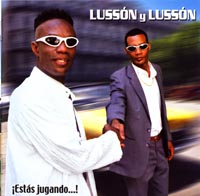
LUSSÓN Y LUSSÓN
¡ESTÁS JUGANDO...! (Envidia A70 7123)
This looked a bit suspect: two dudes in shades and goofy coveralls, with a vintage American car on the cover. Is this Cuban music or marketing hype? I thought. Well it is certainly Cuban music, and in fact excellent Cuban music, which I should have guessed from the fact that it is on the Envidia label. Now my brother has joined the Duchess in thinking that salsa is repetitious, relentless and overall boring, so it puts me on the spot when I want to defend something I think is good. This one is worth going to the mat for (especially with La Duchessa!) It's old style salsa with heavy son and guaracha influences and is the second release from the Lussón father and son team who have a top notch band behind them in this recording. The father grew up singing though he had a hard life and suffered for his black skin hue in the 1950s. So I guess we will overlook his lapse in taste in not only the green pastel shirt with blue pastel coveralls in the cover photos, but the giant sleeveless gold satin jumpsuit he's wearing inside (with those white shades!) that make him look like a blind Teletubby. In the 1980s he joined the famous Chepin-Choven orchestra (which also produced Ibrahim Ferrer) as singer. After a long run in which he became known as a master of the classic son and guaracha style, he joined the even more famous Chappottin y sus Estrellas, part of the heritage of Arsenio Rodriguez, led by Felix Chappottin. Chappottin's son "El Nino" plays with their current band alongside a monster trombonist, Fidel Camué, and Eloy Abreu on second trumpet. Though he's compared to Pio Leyva, I find Lussón Sr has a more robust voice. The exceptional pianist Eduardo Cana wrote a tribute to Compay Segundo which appears with another tribute "A tí Benny Moré," written by Miguelito Cuni. Lussón Jr only sings lead on one track, "Que no sea de mil maneras," which he wrote, but he puts forth a great coro throughout. This was recorded in March 2005, but it has a timeless air to it.
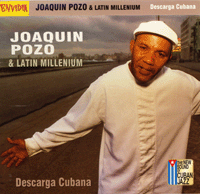
JOAQUIN POZO & LATIN MILLENIUM
DESCARGA CUBANA (Envidia A70 7106)
The Barcelona-based label Envidia sought out some hot young Cuban jazz, and found the grand-nephew of legendary conguero Chano Pozo romping on the skins in the solar where Chano launched forth to New York in his short-lived but stellar career. Rolando de la Rosa on sax has been boning up on his Coltrane. Young Yonny Alvarez on piano has that deft classical touch that adds so much to Cuban encuentros. Add "El Niño," the progeny of Chappottin, on trumpet and you have a great session. Joaquin toured the world in the salsa boom of the early nineties then settled down to teach at the National Arts School in Havana. From these classes he formed his group in 2001, after winning Cuba's top tambor award in 2000. (From my syntax you can tell I've been reading Spanish liner notes!) It's straight-ahead Cuban jazz, well within the tradition ("If you don't know it, don't try it," they say), but interesting enough for all its traditional structures. After a brief "Gershwing" piano solo, there's an effective reggae bass-line to "Momentos," which is a nice change, but it is quickly subsumed by a fierce piano montuno, shrieking trumpet, then it segues into a lyrical ballad on the sax, which builds back to a fiery montuno. Don't be put off by the homely name and generic title, this is a fine album which balances some great conga playing with creative new jazz. The liner notes claim it as a live recording, which adds to the urgency, though I wish they had left on applause or intros to substantiate their claim. It is exceedingly well recorded: the crisp percussion comes through loud and clear.
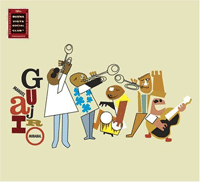
BUENA VISTA SOCIAL CLUB (TM) PRESENTS
GUAJIRO MIRABAL(World Circuit/Nonesuch 79810-2)
I am not opposed to Buena Vista Social Club. I have a few gripes, it's true. One is that little Trade Mark insignia in the name which shows the serious marketing intent behind their every note. But Nick Gold is entitled to his millions, as long as he keeps putting out records. On reflection it's the public I object to, which is a hopeless situation. The original Buena Vista was a bunch of old timers (really old timers) and Ry Cooder cruising through some standards of the Cuban repertoire which had been done far better by many other groups. The toothless blinkered public thought it was the greatest thing since cream cheese, eating up all the subsequent releases without even looking at the adjacent bins to check out Abelardo Barroso or Yuri Buenaventura. The juggernaut ploughed onwards as some of the original members inevitably croaked and like the far superior Vieja Trova Santiguera, some younger members were introduced. Now it's time for a spotlight on Manuel "El Guajiro" Mirabal, octogenarian trumpeter and a fine band paying tribute to the greatest of them all: Arsenio Rodríguez. From the cartoon cover, which is a knock-off of Arsenio's SABROSO Y CALIENTE cover, to the repertoire which includes "Chicharronero," "Dombe Dombe," "El Reloj de pastora," and other Arsenio hits, it's a class act. The rhythm section of Cachaíto López on bass and Miguel "Anga" Díaz on congas is becoming as legendary as Arsenio's own back-line. Papi Oviedo on tres was an obvious choice, he is one of the great exponents of the instrument and a true link to the sound of the son montuno which Arsenio pioneered. "Guajiro" (Countryboy) Mirabal brings back his cohorts from the Orchestra Rumbavana days: Luis Alemany and Alejandro Pichardo on second and third trumpets. This trio played together for 30 years in the pit of Havana's Tropicana nightclub. The rest of the band replicate the line-up of Arsenio's conjunto from the 40s, including a bright young spark on piano: Roberto Fonseca. Some of Mirabal's quotes date him: "Holiday for strings" pops up in "Mi corazón no tiene quien lo llore" and "Windmills of your mind" (sic!) in "Dueda" which he quotes then tries to cover up! It would be impossible to top Arsenio's 1940s band, with Lili Martínez on piano and Felix Chappotín on trumpet, but this is a wonderful homage and clearly recorded. There is one link to Arsenio and that is the appearance of the great Rubén González (who was Arsenio's pianist in the late 30s) on piano on the last cut.
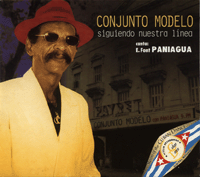
CONJUNTO MODELO
SIGUIENDO NUESTRA LINEA (Envidia A70 7111)
I have this recurring conversation with deejay IJ. "What's new and exciting in the world of world music?" I ask him. "Nothing," he replies. So then I idly poke through the bins on Rasputin music's mezzanine of world music. I chanced upon this Conjunto Modelo disc and bought it. Intrigued, he put it on the store's sound system and immediately a shopper wanted a copy. "You've haven't lost your touch," he tells me. Modelo were the black conjunto; their African-ness showed in a time when Cubans wanted light-skinned musicians serving up their watery iced cha-cha-chás. They were formed in 1940 when Arsenio Rodriguez was pioneering the son montuno and rearranging the line-up of Cuban groups. The traditional sextet line-up consisted of botija, clave, bongó, guitar and tres, backing the singer. Arsenio added a trumpet and replaced the botija with a bass. He took the tresero's montunos of Oriente province he had grown up with, and underlay a Congolese rhythm called the Diablo. The sound was still not dense enough for him so he massed the trumpets by adding a couple more, and added a piano and tumbadora, creating modern Cuban music in one inspired go. Musicians called the new line-up la chambelona. Arsenio would later add the guiro and more brass instruments but the format of Cuban music was revolutionized for ever. In 1953 Arsenio went to New York for an (unsuccessful) eye operation and stayed in North America. His tres player, famed arranger Niño Rivera, regrouped Conjunto Modelo from the left-overs of Arsenio's band who merged with members of trumpeter Felix Chappotín's band. They cut a few sides which went into legend (available on Tumbao TCD059). But Rivera was called away by other bands and, lacking good management, the band folded. Now, fifty years later, a group of young musicians has decided to take up the name of Conjunto Modelo and revive their repertoire, as well as creating new music in their spirit. There are a couple of vocalists from the old days, Eduardo Font a.k.a. Paniagua (from Chappotín y sus Estrellas), and Eduardo Sandoval. Jesus Chappotín is on trumpet and the rest of the group are younger guys with affinities or ties to the originals (Miguelito Cuni sang on Modelo's 1953 sessions and his son plays percussion here.) You can enjoyably compare their versions to the originals by Modelo and by Arsenio's original group with Lili Martínez on piano and Lázaro Prieto on bass.
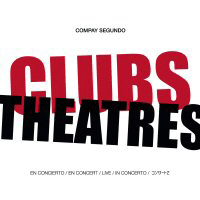
COMPAY SEGUNDO
EN CONCIERTO/EN CONCERT/LIVE/IN CONCERTO ETC (Warner Latina 61931-2)
No matter how much you might will it, Francisco Repilado, aka Compay Segundo, is dead. However the juggernaut of Warner Brothers music seems to think that there are fans clamoring for more versions of "Chan Chan," and there must be, hence this further installment of his music, recorded on two discs, one titled CLUBS 1995-6, the other THEATRES 1998-9. (The CLUBS disc wouldn't work in my regular CD player, being some kind of new-fangled "advanced" CD, so I had to play it in my TV's DVD player.) The set list is different from what you find on GRACIAS COMPAY, but his vocals are still shaky (this being the end of his career). However never-can-say-goodbye Compay fans will snap this up particularly because the CLUBS set is a good intimate live recording with banter. Personally I love this kind of chamber music: two acoustic guitars, bass, and percussion with harmony vocals doing son and guajira classics. I don't mind that the repertoire hasn't changed much in 60 years, because the songs of Miguel Matamoros -- "El Paralitico," "Son de la Loma," and "El Tren" -- always sound fresh. In the CLUBS Compay and his boys are just giving it their all for a small crowd of about 50 lucky listeners. The rapport is immediate, the minor glitches, flat notes and flubbed leads, don't detract. Compay as always speaks better than he sings and his guitar playing is muffed but endearing. The THEATRES set is very well recorded and features a larger ensemble, including the twin clarinets we encountered on the GRACIAS COMPAY album. But the Buena Vista hoopla had hit and Compay had slowed down. The repertoire is portentious, more self-consciously aware of history. Almost the whole of the second disc overlaps the GRACIAS COMPAY release. The band take things at a stately pace and his voice is a lot weaker, making the whole set much more tentative. This compilation is interesting but only the first disc is compelling. I wish they had issued it separately. So let's hear it, one more time, for the great Compay!!
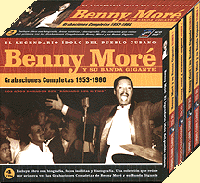
BENNY MORE & SU BANDA GIGANTE
GRABACIONES COMPLETAS 1953-60 (TUMBAO TCD 309*)
Benny Moré, "the legendary idol of the Cuban people", had a voice equal to the great American singers like Nat "King" Cole or Sam Cooke. His Gigantic Band pioneered a smooth kind of instrumental backing that echoes the work of Nelson Riddle and the American big bands in the Swinging Sinatra era & influenced every subsequent band in Cuba and Puerto Rico. I've often thought the way Sinatra's voice would hover then swoop to catch up to the band must have come from his seeing Benny Moré in Havana in the days of mobsters and casinos. Moré is so much a legend that I was astounded once to meet someone who had seen him perform. How can that be? I asked since the person was my own age. Apparently Moré's popularity was so great he would give Saturday matinee concerts for working women and mothers who couldn't catch his night-club act. My acquaintance was then a little boy running around in the large dark nightclub in the afternoon while his mother stood entranced before the stage.
Like too many artists out of synch with the real world, Moré drank a lot and became unpredictable, often missing concerts. He had recurring laryngeal infections probably from straining his voice then medicating himself with booze. But, like Billie Holiday, when he was on he was red hot. His music was essentially roots music, drawing heavily on Afro-Cuban traditions, but he could do any style: biguine, mambo, guaracha, son montuno, and make it uniquely his own. He is arguably the greatest interpreter of the bolero ever. At first he was known as the Barbarian of the Rhythm, then the Barbarian of the Melody, but, to me, neither title really suited his style. He was rebellious and original but not barbaric. Trying to escape his harsh childhood and intended life as a sugar cane cutter, he moved to Havana and tried out for all the talent shows and radio contests. Fame was elusive but he did land a gig singing with the Conjunto Matamoros for a tour of Mexico in 1945. After the year-long tour, he stayed in Mexico and in 1947 made his first, spectacular recordings with Perez Prado where the warm colouring of his voice is already in full effect. Returning to Cuba, he fronted the band of Ernesto Duarte scoring a hug hit with "Como fue (how it was)", but differences caused him to split from Duarte and form his own Banda Gigante. From 1955 to 1957 they were on top of the world, touring Venezuela, Jamaica, Haiti, Mexico, Columbia and the US. Moré even sang during the 1957 Academy Awards in Hollywood after narrowly escaping from jail in Caracas for assaulting a promoter who tried to stiff him. Journalists at home were already proclaiming his successor. Fame and fortune brought many problems which he exacerbated. When doctors diagnosed cirrhosis of the liver he responded by having a tequila drinking contest. His health deteriorated from the late 50s as he quickly destroyed himself with alcohol, dying aged 43 in 1963.
This four CD set is astounding. While it doesn't include "Como fue," it has so many hits that it is a treat to listen to all the way through. Sonically it is very fine (a decade ago the original masters were rediscovered in the RCA vaults and digitally restored), though a few songs have been taken from records. In addition the box includes a 124-page booklet with lots of photos, detailed notes on the songs, composers and musicians, and all the lyrics. There is one amazing glitch for so meticulous a production: disc four track two is supposed to be the bolero "Por que pensar asi?" but is a repeat of "Oh, vida" from disc 2. It's not a big deal as "Oh vida" is a masterpiece but I wonder what happened to the other track. It does appear on two other CDs: GRANDES VOCES DEL BOLERO (CANEY CCD 801) and THE VERY BEST OF BENNY MORE VOL 2 (RCA).
The 15-piece band is stunning. Subsequently well-known band members are Chocolate Armenteros, on trumpet, Generoso Jiménez, trombone, and Chombo Silva on bass saxophone. Miguelito Cuni was second voice for a while. The arrangements are lush and complex: listen to "Oh Vida" or "Y hoy como ayer" which are like mini symphonies. However the Afro-Cuban percussion is something you don't find in Rachmaninov or Shostakovich. The band members were much in demand and many of them played with several other orchestras so there were often substitutions for tours or even recording dates, but their musicianship is the greatest.
If like me you are hesitant because of the cost or the fact that you have a lot of this stuff on other albums, rest assured, this is a crucial brick of music, and a cornerstone of any Cuban collection.
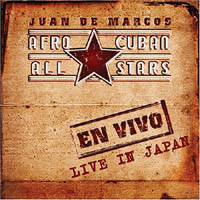
AFRO-CUBAN ALL STARS LIVE IN TOKYO
(Globe Star Recording B000286S7O)
After being ignored by the Buena Vista Socialites, Juan de Marcos Gonzales proved that living long is the best revenge. While the aging Buena Veestans have croaked by turns, he put together an outfit of younger talents and has been exploiting the BV brand name in an ongoing world tour. Stopping in Tokyo in 2001, they were caught on film by the local tv company and that concert is now out on CD and DVD. The red version apparently has some compression problems, so you are urged to look for the brown volume, according to those in the know. I don't think it is worth owning, but I enjoyed seeing it. The filming is pretty good (light years better than the desperate Wim Wenders junk that was so popular) and the sound is exceptional, especially considering how big the band is, but the repertoire is lacking and there are no real solos. The keyboard player does get to show off a bit but not enough. It is a completely different band from the one that made that great first Afro-Cuban All Stars album and toured to promote it. Juan de Marcos has grown into a prize twit. Now he's in the limelight and all the songs include a namecheck for him, he is wearing a gold zoot suit and acting like the cat that ate the canary. Too bad. I guess he's overcompensating. His once decent tres playing is crap. He does a couple of perfunctory solos with a heavy effects pedal distorting his sound. At least he had the decency not to solo on the Arsenio Rodriguez track. The sad thing about the show is that the material is all the stuff he did so well with his old band Sierra Maestra, but they have re-arranged the songs for big band and it doesn't really fit. The songs are well known, but it would have been smarter to use the songs written for the big bands of Machito or Prado, rather than the simple Trio Matamoros & Arsenio stuff that sounds so bloated in this format. The audience is having a good time, though no one is dancing. The old singers come out and do their stuff, including an Omara Portundo look-alike to fool the audience, but the young lead singer is rather shabby. I kept waiting for a round of solos from the massive horn assembly, but it didn't come. Still, an amazing amount of talent came out of Sierra Maestra. Cubanismo is the best offspring and it seems that Juan de Marcos is trying to keep up with Jesus Alemany, but he doesnt really cut it, even if his sales are higher.